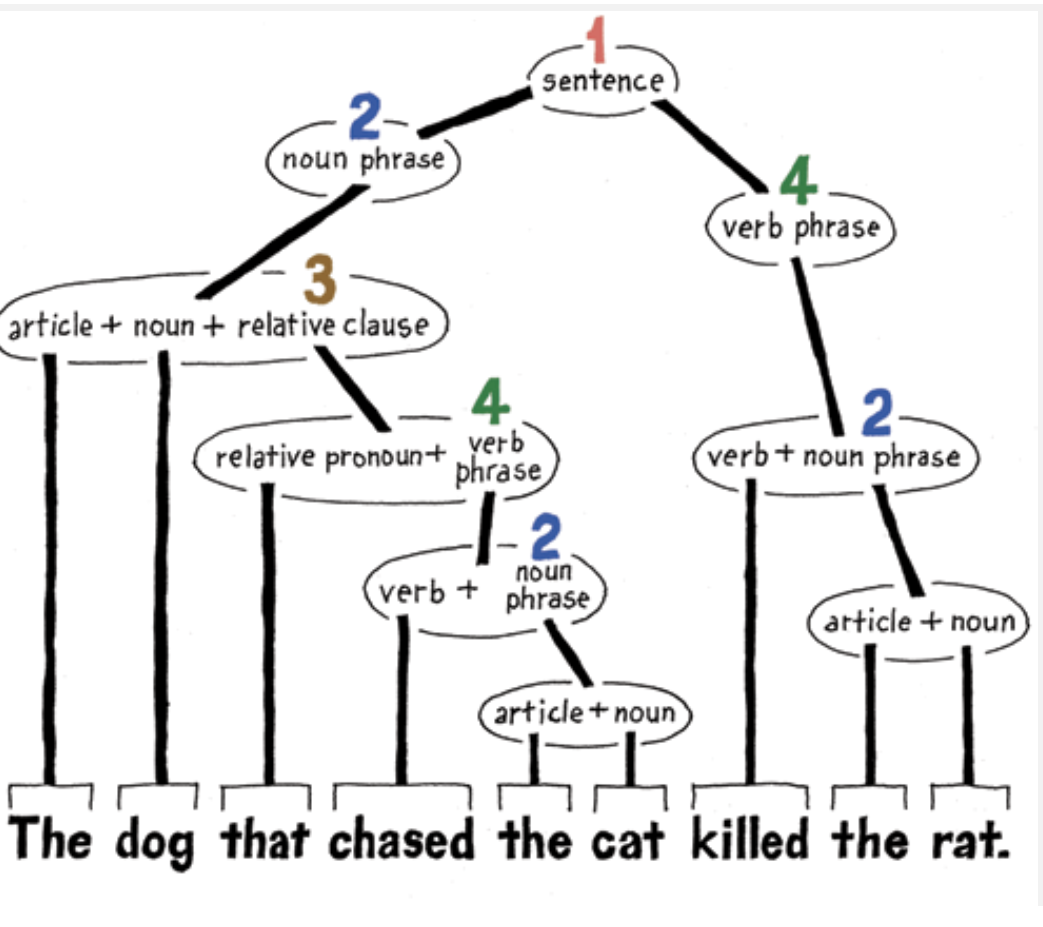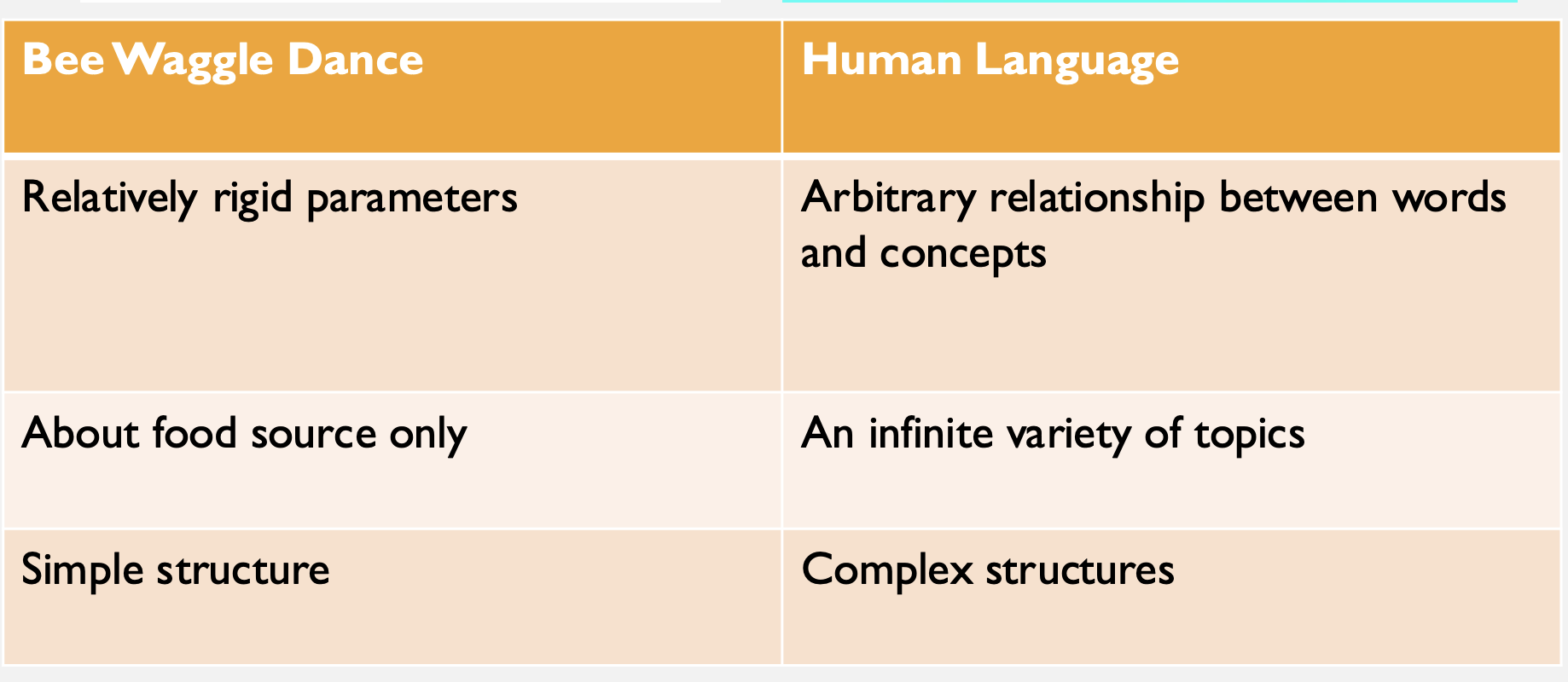PSYC 105: L7 Intro to Language Flashcards
1/20
There's no tags or description
Looks like no tags are added yet.
Name | Mastery | Learn | Test | Matching | Spaced |
|---|
No study sessions yet.
21 Terms
What does the Bee Waggle Dance and the Vervet Monkey Calls show us?
Animal communication; that even though animals don’t have speech, they have a means of communication. For bees, they communicate the location of a food source by the direction, length, and frequency of the buzzing. For monkeys, it means that the kind of noises they make are important for identifying dangers.
Def Hierarchical Organization of Language and name the -omes from smallest to largest
The hierarchical organization of language refers to how language is structured in small to large building blocks.
Phonemes
Morphemes
Lexicon
Syntax
Semantics
Pragmatics
Phoneme
Smallest unit of sound; phonology = how sounds are used to make up words
dog —> duh - uh - og
Morpheme
Smallest unit of meaning; Morphology = How morphemes are combined to make up words
Lexicon
Representations of words, mental dictionary of all the information we know about a word
Syntax
Rules governing how words are combined to form sentences (grammar)
Semantics
Literal meaning of words and sentences
Pragmatics
Meaning in context
Name and define 5 of Hockett’s design features of human language.
Arbitrariness = Abstract symbols determined by convention; no inherent relation between sounds and meanings (dog, cat, bed, etc)
Displacement = The ability to talk about things and ideas not in the here and now.
Duality of Patterning = Combinations of otherwise meaningless units that are meaningful.
Productivity = Speakers can create novel utterances they have never heard before - can create an infinite set of meanings with a finite set of units.
Reflexiveness = Can use the language to talk about the language itself.
Recursion
Embedding structures within structures; hierarchical and potentially infinite.

Def Nativism/Nature (and give 2 pieces of evidence) vs Behaviorism/Nurture
Nativism/Nature = The theory that humans are biologically predisposed to acquire language. (Chomsky example)
Language Acquisition Device —> general rules and constraints ingrained in all humans
Poverty Stimulus —> children can produce novel structures + can learn based on limited + imperfect input
Nurture/Behaviorism = The view that language is just like any other animal behavior, shaped by conditioning through repetition and reinforcement.
What are two examples of evidence for nativism?
Animals have some successes with word learning, but not with grammar. Some evidence that some animals can comprehend the implications of word orders, but there is no
strong evidence that they can produce complex grammatical structures. (Nim Chimpsky, Koko the gorilla, Kanzi the bonobo)
Human children pick up grammar rapidly and without explicit instruction.
What is the Sapir-Whorf hypothesis?
The structure of a language determines a native speaker's perception and categorization of experience.
Linguistic Determinism = Language limits or determines thought (stronger version).
Linguistic Relativity = Language affects thought and behavior (milder version).
An even milder version (most likely to be true): Language affects processing on certain tasks where linguistic encoding is important.
Linguistic Relativity
Language affects thought and behavior (milder version).
Experience shapes thought
Language may be part of that experience, but it is not the only determinant of cognition (indirect)
Instead of determining thought, effects of language are perhaps better described as:
Expertise in categorization
Increased attention
Limits to expression
Codability
Higher agreeability on labels, usually shorter in length, easier for speakers to come up with.
What did the '“Russian Blue Study,” show us?
Categorical Perception = The perception of distinct categories when there is a gradual change in a continuum.
Distinguishing within-category items is harder and takes longer
than distinguishing between-category itemsRussian speakers might have a stronger mental categorization for different blues.
Conceptualizing/categorizing the world in a certain way might be easier if your language has words for those distinctions.
Name 3 characteristics of the Bee Dance vs Human Communication

What are some similarities and challenges with language + thought?
Similarities = they are both thought of as our “inner voice”
Challenges =
People have thoughts we can’t articulate
Pre-verbal infants + animals are capable of thinking without language
Adults without language still have thoughts
What does the example of snow show us?
Vocabulary differences are unlikely to have significant difference on perception.
They reflect differences in experience and expertise.
What does grammatical gender show us?
Grammatical gender may focus speakers of different languages on different aspects of objects.
Ex.=
Spanish and German speakers were asked to write down the first 3 English adjectives that came to mind for objects with opposite grammatical genders in the 2 languages
• “Key” (Masc. in German, Fem. In Spanish)
German: hard, heavy, jagged, metal, serrated
Spanish: golden, intricate, little, lovely, shinyGrammatical gender affects performance on some tasks that use language.
What is an example of spatial representation of time between the English and mandarin language?
English and Mandarin both have front/back horizontal time metaphors (looking forward to the future, looking back on the past)
Mandarin frequently uses vertical metaphors as well
(e.g., 上“up” for earlier events and 下 “down” for later events)Both groups showed left-to-right representation of time
Only the Mandarin group showed top-to-bottom representation of time
Linguistic metaphors guide spatial representation of time.